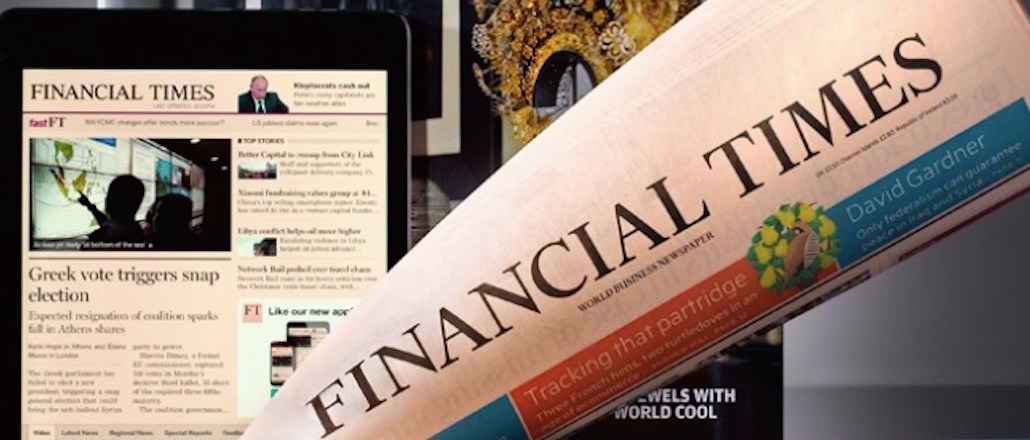Save 50% on a 3-month Digiday+ membership. Ends Dec 5.
The JavaScript diet: The Financial Times adopts a ‘culture of subtraction’ to boost page speed

The Financial Times is starting the year with a diet — for its webpages, which have been slowed with all manner of ad tech and analytics gunk over the years. That means, according to FT product head Bede McCarthy, going from a “culture of addition” to a “culture of subtraction.”
The rise of ad blocking has been a wake-up call at many publishers to take a hard look at the user experience. At the FT, that comes down to speed. The goal: get pages to load in under a second, down from the 14 seconds it could take for a page to fully load on its previous legacy site, according to McCarthy.
“We want to understand the relationship between speed and engagement so that when a stakeholder asks us to add a script because it will increase revenue by X, then we can understand that adding 0.5 seconds of load time will affect engagement and subscriptions by Y,” McCarthy said. “Previously, we didn’t have any framework to make those trade-offs.”
The focus on page load time comes as the FT is building the next version of its site, dubbed “Next FT,” and A/B testing to determine how user engagement is affected by page-load speeds. Some pages are being run deliberately slowly, according to McCarthy.
There are two main load speeds the FT measures: “initial load,” which is what it takes to get content in front of a user, and “total load,” when all the asynchronous scripts have completed. The latter takes much longer and often is unnoticed by the user, McCarthy said.
Currently, the FT averages 1.5-2.o seconds to load the content and about 4.0-4.5 to load the rest in the background, according to McCarthy, although those times also include the users for whom the publisher is deliberately slowing down the site. A test on Pingdom found the FT.com homepage takes over four seconds to load currently.
The publisher is also scrutinizing typefaces, coding and ad tech used on pages to see what is hindering page-load speeds, particularly on mobile, where bounce rates are typically higher for all publishers.
Ad position: web_incontent_pos1
The FT has an advantage over most publishers that are heavily reliant on ad revenue: It has 550,000 digital subscribers who can either pay a weekly £7.55 ($10.80) for a premium subscription, or £5.35 ($7.65) for a standard subscription. That means that while ads are a part of the revenue equation, they’re not the be-all, end-all. Having multiple revenue streams makes it easier to improve its existing products rather than create new ones using the latest tech, according to McCarthy.
“The term ‘mobile-first’ has become a cliché, but it’s forcing publishers to make difficult decisions. Viewing our site through the lens of speed is everything now,” he said.
The FT site is less cluttered than some of its peers with trackers that slow sites down, according to Ghostery. The FT homepage has 13 trackers, according to Ghostery. The Wall Street Journal has 24. There is still room for improvement, though. According to Google’s PageSpeed Insights tool, the FT’s homepage scores 40 out of 100 for mobile performance. Desktop ranks slightly better, at 59.
Next FT’s design, content and ads reflect its aim of being more customer behavior-focused, he said. It is now adopting what Bede calls a “front-page mentality” of print when designing mobile experiences, ensuring the content and features are stripped back to the bare essentials. For its webpages, it cut back on ads, marketing scripts and analytics tools.
“There are a plethora of tech companies pitching anything from analytics packages to personalization software, all stuff that can slow things down,” McCarthy said.
Ad position: web_incontent_pos2
Of course, Google and Facebook both now offer speedy mobile page-loading options for publishers via Accelerated Mobile Pages (AMP) and Instant Articles. McCarthy said the FT is also running experiments with AMP to see what design experience works best with the new capabilities.
Image courtesy of the FT.
More in Media

What publishers are wishing for this holiday season: End AI scraping and determine AI-powered audience value
Publishers want a fair, structured, regulated AI environment and they also want to define what the next decade of audience metrics looks like.

Digiday+ Research Subscription Index 2025: Subscription strategies from Bloomberg, The New York Times, Vox and others
Digiday’s third annual Subscription Index examines and measures publishers’ subscription strategies to identify common approaches and key tactics among Bloomberg, The New York Times, Vox and others.

From lawsuits to lobbying: How publishers are fighting AI
We may be closing out 2025, but publishers aren’t retreating from the battle of AI search — some are escalating it, and they expect the fight to stretch deep into 2026.
Ad position: web_bfu
